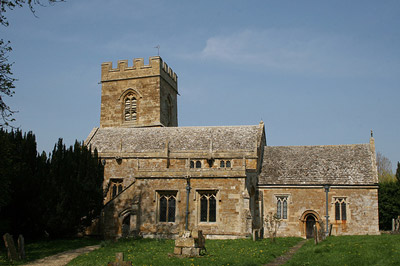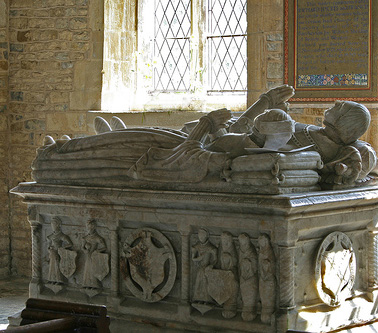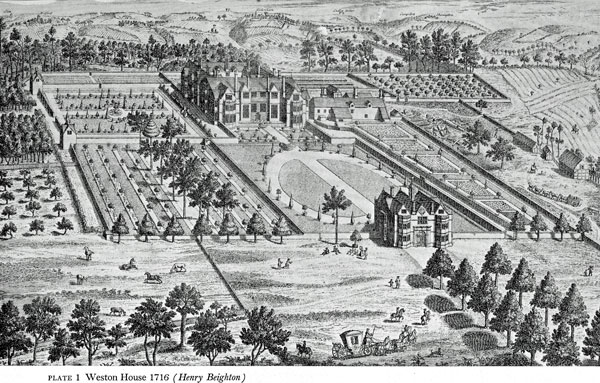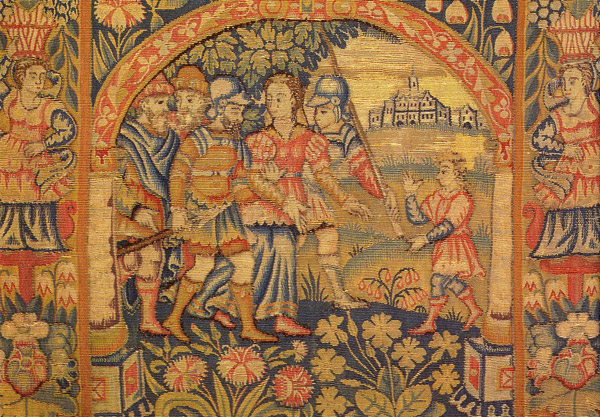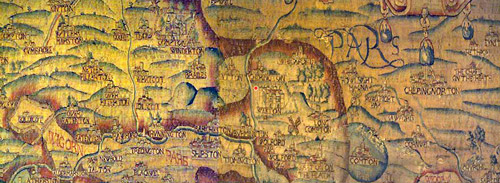|
William and Ann had seven daughters, the third of whom, Mary, married c. 1535 William Sheldon from Beoley in Worcestershire. He had acquired in 1534 the nearby Weston Estate, on the edge of the village of Cherington, which in 1545 became known as Weston Park. As can be seen, the daughters are carved on the side of the Willington tomb; Mary with the shield on which is carved the Sheldon heraldic emblem of three shelducks. It was this marriage that was to be responsible in due course for the tapestry weaving established in Willington's old house in Barcheston.
William Sheldon was a wealthy and influential figure in the Midlands of Tudor England. Apart from the estates he inherited, as the King's Receiver of the monastic lands throughout Warwickshire, he managed to add to his property holdings and, together with his father-in-law William Willington, dealt in property throughout the Midland counties. In 1537 Mary Sheldon bore William a son, Ralph. Until recently, it had been held for many years that he was educated at Oxford, then sent abroad by his father with a certain Richard Hyckes, supposedly a local South Warwickshire man, to learn the art of tapestry weaving, and that Richard Hyckes was possibly apprenticed to a Dutch arras or tapestry weaver. There is however no documentary evidence for any of this, just references to Oxford and travel in foreign parts in his epitaph, composed by his son. Modern research suggests that Hyckes, or Heekes, was himself a Flemish immigrant weaver.
Be that as it may, it is clear from William Sheldon's will that he had set up a tapestry-weaving industry at Barcheston, near to his house at Weston, and put Richard Hyckes in charge. He had also founded works at Bordesley, possibly in the ruins of the old monastery, near to his house at Beoley, where a Thomas Chance was responsible for the looms. Both Richard and Thomas were assisted by a William Dowler, a family name still to be found in the area around the small town of Shipston-on-Stour (a mile from Barcheston).
Various records from the late 16th century make reference to the tapestry weaving at Barcheston, including the delivery of tapestries to Grafton Manor, near Bromsgrove, in 1568 and Bess of Hardwick's building account book of 1592 refers to paying Mr Sheldon's man in respect of tapestries for Hardwick Hall. Tapestry maps, probably based on Christopher Saxton's series of maps of the English counties, published between 1574-9, were woven in the 1580s and adorned three walls of the dining room of Weston Park, the grand Elizabethan house built by Ralph Sheldon in 1588 but demolished in the early 19th century. It has traditionally been held that these maps came out of the Barcheston works, and this seems logical in view of their destination, although no documentary proof exists.
|


